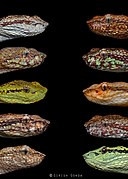Craspedocephalus malabaricus
| Craspedocephalus malabaricus | |
|---|---|

| |
| Цветные морфы Craspedocephalus malabaricus | |
| Научная классификация | |
| Домен: | Эукариота |
| Kingdom: | Animalia |
| Phylum: | Chordata |
| Class: | Reptilia |
| Order: | Squamata |
| Suborder: | Serpentes |
| Family: | Viperidae |
| Genus: | Craspedocephalus |
| Species: | C. malabaricus
|
| Binomial name | |
| Craspedocephalus malabaricus (Jerdon, 1854)
| |
| Synonyms | |
|
List | |
Craspedocephalus malabaricus , (ранее Trimeresurus malabaricus), широко известный как малабарская яма , малабарная каменная яма Viper , [ 3 ] или рок -гадюка , [ 4 ] является ядовитым гадюки видом , эндемичным для высоких высот западных Гат юго-западной Индии . Недавно этот видовой комплекс был разделен на три различных вида, Craspedocephalus malabaricus (к северу от Palghat Gap), Craspedocephalus travancoricus (к югу от Shengottai Gap), Craspedocephalus anamallensis (юг Пальгхат -Гэп до севера Шенготтай). [ 5 ]



Описание
[ редактировать ]Взрослые могут достичь длины морды (SVL) 105 см (41 дюйм). Хвост претендент . [ 6 ]
The weakly keeled dorsal scales are arranged in 21 or 19 rows at midbody. Ventral scales in the males number 143-158 and in females 136-159. Anal scale entire. Subcaudals paired and numbering 50-63 in males, 44-54 in females. Internasals large and usually touching. There are 9 or 10 supralabials, the first completely separated from the nasal. There is a single row of scales between supralabials and elongate subocular. The temporal scales are smooth or obliquely keeled.[7]
Many different colour morphs are known to exist, including colours such as yellow, green, and brown. Shown here is a brown colour morph with pattern.
Distribution and habitat
[edit]The species is endemic to Western Ghats mountains, occurring along the southern and western India at 600–2,000 metres (2,000–6,600 ft) elevation. The type locality is the Western Ghats of southwestern India. Records of this species are from Slient valley, western Nilgiris, Wayanad, Coorg, Malnad region of Karnataka, Castle Rock, Goa and northwards into Maharashtra in the Amboli hills. Kolhapur area.[8] It inhabits riparian forests and is very partial to hill streams and torrents, situated within dense wet rainforests, sometimes also evergreen and deciduous forests, where it may be found on the ground, on rocks present in stream beds, on low vegetation, or in shrubs.[6][verification needed]
Ecology
[edit]The Malabar pit viper is nocturnal and usually inactive in the day, sometimes seen basking on rocks or trees near streams. It is more commonly encountered during the monsoon months. The species preys upon frogs, lizards, nestling birds, musk shrews, mice and other small animals.[6][verification needed]
Venom
[edit]C. malabaricus is slow-moving, but capable of fast strikes. Its venom causes moderate pain and swelling to humans. These symptoms subside in a day or two.[7]
References
[edit]- ^ Srinivasulu, C.; Srinivasulu, B.; Shankar, G.; Thakur, S.; Kulkarni, N.U. & Jose, J. (2013). " Craspedocephalus malabaricus". IUCN Red List of Threatened Species. 2013: e.T172708A1372028. doi:10.2305/IUCN.UK.2013-1.RLTS.T172708A1372028.en.
- ^ The Reptile Database. www.reptile-database.org.
- ^ Gumprecht A, Tillack F, Orlov NL, Captain A, Ryabov S. 2004. Asian Pitvipers. Geitje Books. Berlin. 1st Edition. 368 pp. ISBN 3-937975-00-4.
- ^ Mehrtens, John M. (1987). Living snakes of the world in color. Sterling Pub. Co. ISBN 9780806964607.
- ^ Mallik, Ashok Kumar; Srikanthan, Achyuthan Needamangalam; Ganesh, Sumaithangi Rajagopalan; Vijayakumar, Seenapuram Palaniswamy; Campbell, Patrick D.; Malhotra, Anita; Shanker, Kartik (6 October 2021). "Resolving pitfalls in pit viper systematics – A multi-criteria approach to species delimitation in pit vipers (Reptilia, Viperidae, Craspedocephalus) of Peninsular India reveals cryptic diversity". Vertebrate Zoology. 71: 577–619. doi:10.3897/vz.71.e66239. ISSN 2625-8498.
- ^ Jump up to: a b c Das, Indraneil. 2002. A Photographic Guide to Snakes and Other Reptiles of India. Ralph Curtis Books. Sanibel Island, Florida. 144 pp. ISBN 0-88359-056-5. (Trimeresurus malabaricus, p. 66.)
- ^ Jump up to: a b Whitaker R, Captain A. 2004. Snakes of India, The Field Guide. Draco books.
- ^ McDiarmid RW, Campbell JA, Touré T. 1999. Snake Species of the World: A Taxonomic and Geographic Reference, Volume 1. Herpetologists' League. 511 pp. ISBN 1-893777-00-6 (series). ISBN 1-893777-01-4 (volume).
Дальнейшее чтение
[ редактировать ]- Jerdon, TC 1854 ["1853"]. Каталог рептилий, населяющих полуостров Индии. Журнал Азиат Соц Бенгалия 22 : 522-534.
- Смит, Массачусетс, 1943 год. Фауна Британской Индии, Цейлона и Бирмы, включая всю индохитайскую субрегиона. Рептилия и амфибия. Тол. III. - Серпентс . Государственный секретарь Индии. (Тейлор и Фрэнсис, принтеры.) Лондон. XII + 583 стр. ( Trimeresurus malabaricus , стр. 513.)




